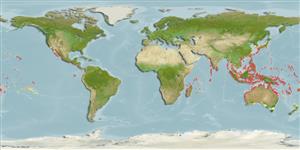Teleostei >
Centrarchiformes (Basses) >
Kuhliidae (Aholeholes)
Etymology: Kuhlia: Because of Heindrich Kuhl, 1797-1821; researcher also with lizards (Gekkonidae).
Eponymy: Dr Heinrich Kuhl (1797–1821) was a German naturalist and zoologist. [...] (Ref. 128868), visit book page.
More on author: Lacepède.
Environment: milieu / climate zone / depth range / distribution range
生态学
海洋; 淡水; 半咸淡水 礁区鱼类; 降海洄游 (Ref. 51243); 深度上下限 0 - 5 m (Ref. 86942). 熱帶; 20°C - 26°C (Ref. 2060)
Africa to Asia and Oceania: East Africa to Samoa, north to the Ryukyu Islands, south to Queensland, Australia and New Caledonia.
非洲到亞洲與大洋洲: 東非到美屬薩摩亞, 北至琉球群島, 南至澳洲的昆士蘭省與新加勒多尼亞。
Length at first maturity / 大小 / 重量 / 年龄
Maturity: Lm 26.5, range 26 - 27 cm
Max length : 45.0 cm TL 雄鱼/尚未辨别雌雄; (Ref. 5329); common length : 25.0 cm SL 雄鱼/尚未辨别雌雄; (Ref. 2847); 最大体重: 2.7 kg (Ref. 5329)
背棘 (总数) : 10; 背的软条 (总数) : 10 - 12; 臀棘: 3; 臀鳍软条: 9 - 11. Diagnosis: Preorbital serrae 10-15 (obsolete in large specimens); body depth 2.6-3.0 in SL; mouth large for genus, maxilla reaching to below posterior half of eye; caudal fin emarginate, lobes somewhat rounded, caudal concavity 5.3-8.7 in head length (Ref. 41640). Reduced number of lateral line scales; 17-18(19) gillrakers on lower part of first bracnhial arch; body with spots (Ref. 79840).
Coloration: Silvery, the scales dorsally on body with black edges, those on side with a black bar or spot; juveniles with a broad black zone, edged above and below in white, in soft portion of dorsal fin, and each lobe of caudal fin with a large, white-edged black spot; black areas in these fins enlarge with growth until in adults most of these fins black (caudal with upper and lower edges and corners whitish) (Ref. 41640).
眶前骨锯齿 10-15;(大的标本退化) 体高 2.6-3.0 分之一标准体长; 嘴对于属是大的, 颚骨延伸到眼的后半段下面; 尾鳍边缘微凹的, 叶略微圆的, 尾部的凹洼 5.3-8.7 分之一头长。 银色的, 鳞片在身体背面有黑边, 那些在侧边上具有一个黑色的横带或斑点; 在背鳍的柔软部位中,稚鱼有被在白色上面与下面边缘的一个宽的黑色区域, 与每个叶尾鳍有一个大的, 边缘白色的黑色斑点; 在这些鳍的黑色的区域随着成长增大直到当成鱼时大部分的这些鳍黑色 (尾鳍有上、下边缘与角落微白色的) 。 (参考文献 41640)
Primarily a freshwater inhabitant but may penetrate adjacent marine habitats (Ref. 41640). Adults occur in estuaries and the middle reaches of rivers; usually in relatively fast-flowing, clear streams (Ref. 2847, 79840). Usually in rainforests, as well as in rocky pools below waterfalls (Ref. 44894). Adults are omnivorous, feeding on small fishes, insects, crustaceans and fruits (figs) that drop into the water. Specific breeding habits are unknown, but adults move downstream into estuaries or to the sea to spawn (Ref. 44894). Neither anterolateral groove nor venom gland is present (Ref. 57406). Good food fish (Ref. 5329).
主要地一个淡水的栖居动物但是可能贯透毗连的海洋栖息地。 (参考文献 41640) 出现于河口与河的中游; 通常在相当快速流动的, 清澈溪流.(参考文献 2847) 通常在雨林, 以及在岩石的水池中在瀑布之下.(参考文献 44894) 成鱼是杂食性的, 吃小鱼,昆虫,甲壳动物与果实 (无花果树) 那一下降进入水。 特定的繁殖习惯是未知的, 但是成鱼进入河口之内移动向下游,否则到海洋产卵.(参考文献 44894) 既不是前外侧的凹槽也不是毒液腺存在.(参考文献 57406) 好食用鱼.(参考文献5329)
Life cycle and mating behavior
成熟度 | 繁殖 | 产卵场 | 卵 | 孕卵数 | 仔鱼
Presumably non-guarders (RF).非洲到亞洲與大洋洲: 東非到美屬薩摩亞, 北至琉球群島, 南至澳洲的昆士蘭省與新加勒多尼亞。
Randall, J.E. and H.A. Randall, 2001. Review of the fishes of the genus Kuhlia (Perciformes: Kuhliidae) of the Central Pacific. Pac. Sci. 55(3):227-256. (Ref. 41640)
世界自然保护联盟红皮书 (Ref. 130435: Version 2024-1)
人类利用
渔业: 商业性; 游钓鱼种: 是的
工具
特别资料
下载 XML
网络资源
Estimates based on models
Preferred temperature (Ref.
123201): 24.2 - 29.3, mean 28.4 °C (based on 2775 cells).
Phylogenetic diversity index (Ref.
82804): PD
50 = 0.5002 [Uniqueness, from 0.5 = low to 2.0 = high].
Bayesian length-weight: a=0.01413 (0.00597 - 0.03345), b=3.06 (2.85 - 3.27), in cm total length, based on LWR estimates for this (Sub)family-body shape (Ref.
93245).
营养阶层 (Ref.
69278): 3.2 ±0.45 se; based on food items.
回复力 (Ref.
120179): 中等的, 族群倍增时间最少 1.4 - 4.4年 (Preliminary K or Fecundity.).
Fishing Vulnerability (Ref.
59153): Low to moderate vulnerability (35 of 100).
Nutrients (Ref.
124155): Calcium = 47.5 [26.2, 74.1] mg/100g; Iron = 0.537 [0.323, 0.863] mg/100g; Protein = 19.4 [18.3, 20.4] %; Omega3 = 0.111 [0.070, 0.175] g/100g; Selenium = 19.4 [11.2, 34.6] μg/100g; VitaminA = 80.8 [27.4, 245.9] μg/100g; Zinc = 1.58 [1.13, 2.15] mg/100g (wet weight);
